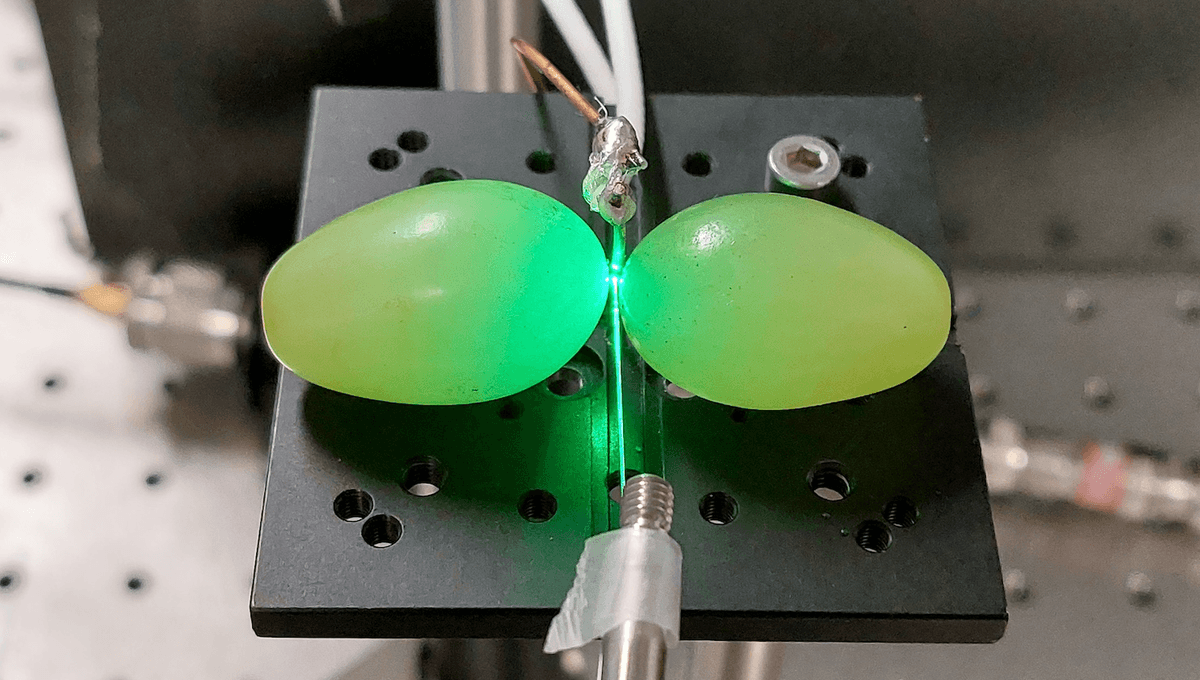
A party trick performed using fruit in a microwave oven could lead to more sensitive detectors of microwave radiation, with applications in fields such as dark matter detection, quantum computing, and satellite communication. Adding a pair of grapes either side of a doped diamond might seem an eccentric habit, but it could signal a low-cost path to improved sensors.
In the 1990s a curious craze swept the world of science nerd-dom, revived in later decades through YouTube videos. If a grape is cut almost, but not entirely in half, and placed in a microwave oven, it will often produce plasma, creating an impressive glow and accompanying sparks. Unfortunately, it will sometimes also destroy the microwave oven, but that is a small price to pay to wow and intrigue your friends, right?
Although proposed physics explanations quickly followed the discovery, many were contradictory or easily disproved with further testing. It took more than 20 years before rigorous research settled the question. Macquarie University doctoral student Ali Fawaz and colleagues realized that while the plasma itself may not be useful, the reason it is produced indicates grapes might enhance the capacity of quantum sensors. They’ve now demonstrated the effectiveness of this approach – with the right grapes that is.
“While previous studies looked at the electrical fields causing the plasma effect, we showed that grape pairs can also enhance magnetic fields, which are crucial for quantum sensing applications,” Fawaz said in a statement.
Fawaz bought the grapes at the supermarket, but the rest of his equipment was a bit fancier.
“Pure diamonds are colourless, but when certain atoms replace the carbon atoms, they can form so-called ‘defect’ centres with optical properties,” said Dr Sarath Raman Nair. “The nitrogen-vacancy centres in the nanodiamonds we used in this study act like tiny magnets that we can use for quantum sensing.” When a green laser is shone on these nanodiamonds they glow red, with their brightness proportional to the magnetic field.
Amplification of the fields allows the sensors to detect even more subtle effects, which is where the grapes come in.
The grape-induced plasma was explained as a consequence of the grapes acting as a microwave resonator, whose shape stored electric fields inside, producing hotspots in which plasma forms. Fawaz suspected the accompanying magnetic fields would be useful where microwave radiation is used to trigger a field for the nanodiamonds to detect.
“We found the magnetic field of the microwave radiation becomes twice as strong when we add the grapes,” Fawaz said.
There is a romantic appeal to the idea that certain grape varieties, with just the right sugar concentrations or flavor molecules, would work best, leading scientists to scour vineyards for the perfect amplifier. We’re sorry to burst the bubble of anyone dreaming of a funded trip to a winegrowing region, but Fawaz says this won’t fly.
“The reason this works is because grapes are primarily made of water,” Fawaz told IFLScience. “It has a high refractive index, which allows the grapes to behave as resonators. The waves bounce around inside the grapes because of a jump in permittivity between the inside and the air outside.”
Sugars and any other impurities “contribute to absorption” Fawaz added, and therefore decrease the effect rather than enhancing it. Bags of pure water held together by some sort of membrane would probably do better, but are not so easily available.
The main grape criteria is size and shape. A length of 27 millimeters (1.06 inches) is perfect for the microwaves Fawaz used. A width of 17 millimeters (0.7 inches) proved appropriate, but most important of all was for the two grapes’ placed either side of the detector to match in size. Other fruits might also work if they’re suitably sized and enclosed, but it’s unlikely they would improve on grapes by much, if at all.
“Water is actually better than sapphire at concentrating microwave energy, but it’s also less stable and loses more energy in the process. That’s our key challenge to solve,” Fawaz said in the press release.
Although the craze that started this used a cut grape, that isn’t necessary, except perhaps to make the plasma more visible. For Fawaz’s purposes it would just ensure the grape dried out faster.
Fawaz explained to IFLScience the reasons microwave sensors are in demand is that, “In most quantum systems we manipulate the spins using microwave fields.” The goal is to cause particles to interact coherently, which requires coupling them to fields. The state of such systems is sensitive to magnetic fields, temperature and pressure and can therefore be used as sensors for all of these.
The sparks that first drew attention to the phenomenon are charges jumping between metallic ions in the grapes’ plasma hotspots. Some ovens have been destroyed when the sparks got out of hand.
Fawaz told IFLScience his study was done using microwave sources far less powerful than a household oven, so damage was not a concern. He cannot confirm rumors the demonstration can be run safely if a glass of water in placed in the microwave at the same time, absorbing enough of the microwaves to protect the oven.
The study is published open access in Physical Review Applied.
Source Link: The Key To Enhancing Microwave-Powered Magnetic Fields For Quantum Sensors May Be… Grapes